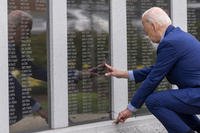
Whether or not the Stryker wheeled vehicle is the right
vehicle for battlefield conditions in Afghanistan is a question that
remains unanswered. What we do know: DOD wants a lot more of them. A drafter
version of the quadrennial defense review (QDR), the once every four year
congressionally mandated strategy review, has been leaked and is making the
rounds in Washington
defense policy circles.
The draft QDR calls for nearly doubling the number of
Stryker brigades while trimming the number of heavy brigade combat teams. The
Army currently has seven Stryker BCTs, six active and one reserve. The draft
QDR calls for up to 13 Stryker BCTs.
Commanders lauded their performance in Iraq where the
eight wheeled vehicle's mobility and smooth ride were a big plus. In Afghanistan,
however, the 5th SBCT, the first Stryker brigade to see combat
there, has suffered heavy losses to IEDs, the Taliban insurgent's force
multiplier.
Influential retired Army Maj. Gen. Bob Scales wrote in a
recent article that appeared in Armed Forces Journal that the Stryker is the
wrong vehicle for Afghanistan.
"The vehicles have proven to be too thinly armored to survive the very large
explosive power of Taliban IEDs and too immobile to maneuver off road to avoid
them," he wrote.
Here's how the draft QDR breaks down a notional future Army
force structure:
- 73 total brigade combat teams (BCTs) (45 AC and
28 RC), consisting of - 40 infantry brigade combat teams (IBCTs) (20 AC
and 20 RC) - 9 -13 Stryker brigade combat teams (SBCTs) (8-12
AC and 1 RC) - 20 -24 heavy brigade combat teams (HBCTs) (13-17
AC and 7 RC) - 20 - 21 combat aviation brigades (CABs) 12 - 13
AC and 8 RC - 18 Division headquarters (10 AC and 8 RC
- 4 Corps headquarters (all AC)








